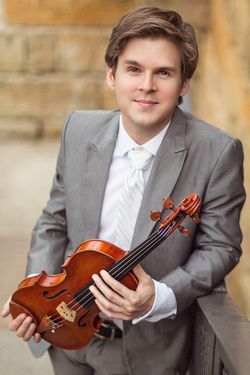| If you are fluent in french, this is the original: Il faut avoir au bon violon et de bonnes cordes. Il vaut mieux ne pas travailler que de jouet avec des quintes fausses. Il faut observer avec quelle grosseur de cordes le violon sonne le mieux et avoir une filiere pour choisie toujours la meme grosseur. Il est de mauvais gout d'accorder son violon en appuyant sur la jambe. Il faut aussi prendre l'habitude de s'accorder pianissimo. Chaque fois qu'on tourne une cheville il fant essayer tres soigneusement le violon et l'archet quand ou a fini de travailler et recouvrir l'instrument avec foulard il faut detendre l'archet. Quand ou jouera assis, il ne faut pas tirer l'archet entre les jambes. Il ne faut pas laisser s'accumuler la Colophane sur le violon, ni surtout sur le chevalet ear au bout de quelque temps il se forme une croute qui fait l'effet d'une sourdine l'intrument. Dans le pays humides ou au bord de la mer il ne faut jamais laisser le violon ni la Colophane a l'air. Quand un chevalet va bien au violon il faut en avoir le plus grand soin car on n'en retrouve pas aisement un qui convienne a l'instrument. La meilleure maniere de se guerir de la transpiration de la main gauche, c'est de continuer a travailler pendant la transpiration, au bout de 10 minutes la main redevient seche. Il faut filer des sons et faire des exercices des doigts et d'archet tous les matins, ma gymnastique que du violiniste en fournira tous les elements. Les 6 Sonates de Bach doivent etre l'etude journalier principale. Savoir travailler, c'est etre artiste. Il faut done travailler lentement, avec conscience, et ne jamais faire de mauvais preludes. Il est bon de jouer dans le orchestres de Symphonies, mais le theatre est pernicieux. On ne peut etre un artiste distingue sans connaitre a fond les Quators, Trios, Sonatas, et en general les ouvres des maitres anciens et modernes. | Hubert Leonard, "chief" of the Belgian School of violin playing and successor of Charles Deberiot is possibly the least known of the great violin pedagogues. Recently, I've been studying his pedagogical works and came across a passage called "Conseils aux Jeunes Violinistes," or "Advice for Young Violinists" from op. 47, "Ecole Leonard." I've worked a couple of Leonard's studies (intervals, introduction to positions 1-4, and several advanced studies) into lessons last week, and they've been extremely effective. Most of the advice is somewhat normal, but the last few I find interesting and inspiring, especially coming from a school where students were given upwards of three 2-hour private lessons per week, and intensive music theory training. A rough translation follows: You have to have a good violin and strings. It is better not to work than to toy with false fifths. (false strings, out of tune violin) We must observe which strings sound the best and have a spinneret(?) (likely a string gauge) forever chosen of the same size. It is bad taste to tune the violin by pressing it against the leg. It must also be tuned in pianissimo. Every time we turn a peg, check it very carefully violin and bow. When or finished working, cover the instrument with a scarf and relax the bow. When sitting to play, do not pull the bow between the legs. Rosin must not be allowed to accumulate on the violin, and above the chin rest. After some time it forms a crust that makes the effect of muting the instrument. When a bridge is fine violin you have to have great care because we do not find a suitable easily to the instrument. The best way to cure sweating of the left hand is to continue working during perspiration, after 10 minutes the hand becomes dry. It must be spinning sounds (sons files) and exercises the fingers and bow every morning. My "gymnastics for violinists" in supplies these exercises. The 6 Sonatas and Partitas of Bach should be studied daily. Ability to work is to be an artist. We must therefore work slowly , consciously , and never play careless warmup exercises. It is good to play in the symphony orchestras, but the theater is pernicious. One can not be a distinguished artist without knowing thoroughly the Quartets, Trios, Sonatas, and in general, the works of ancient and modern masters. |
|
0 Comments
Leave a Reply. |
Matthew ZerweckViolinist in Camerata SA, Former asst. CM of San Antonio Symphony, Eastman School -BM, MM, Teaching Asst. to Prof. Charles Castleman, Performer's Certificate. Archives
April 2018
Categories
All
|


 RSS Feed
RSS Feed